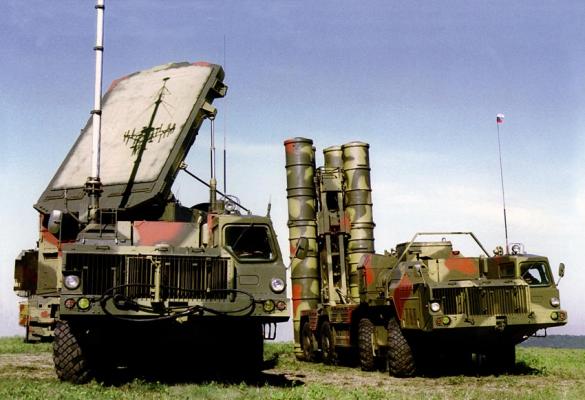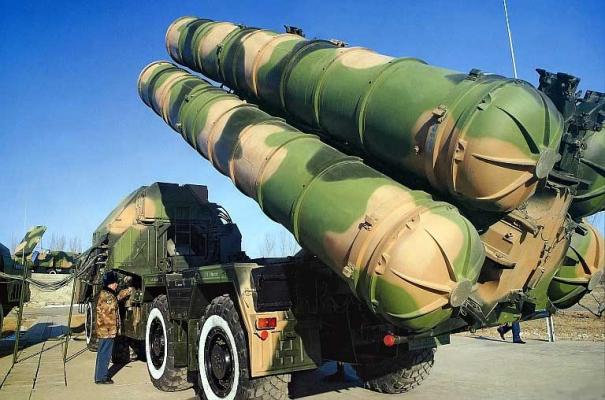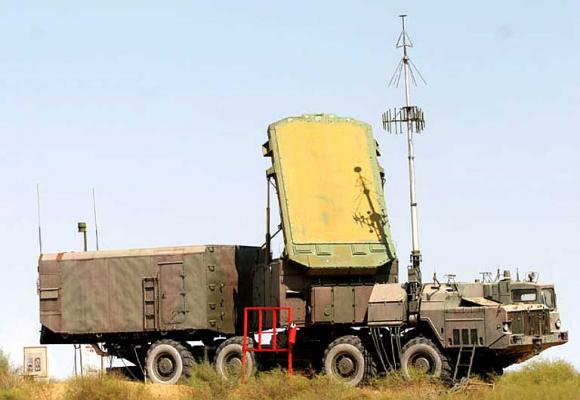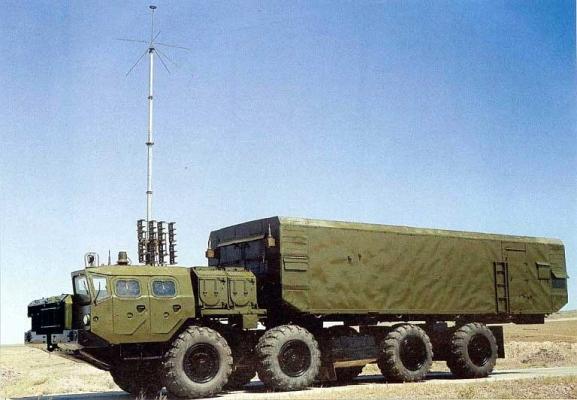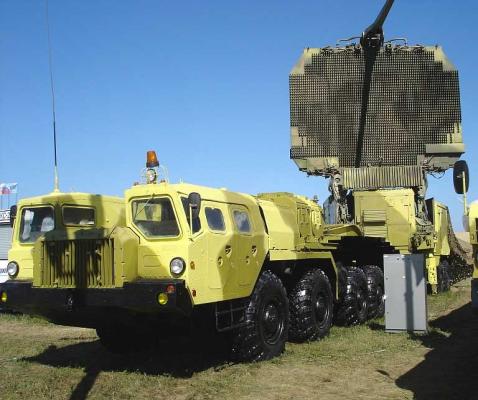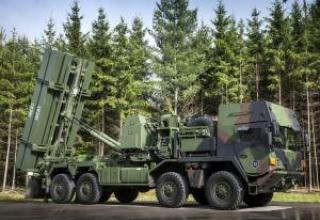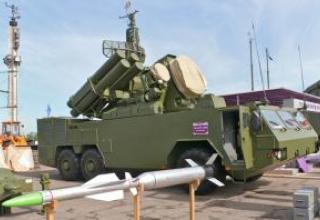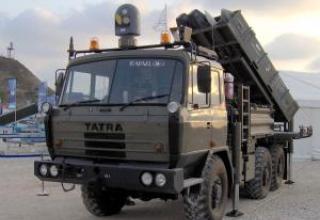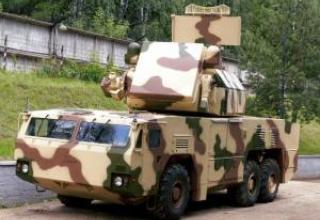The S-300PM mobile multi-channel anti-aircraft missile system (export version S-300PMU-1) is designed to protect critical administrative, industrial and military facilities from attacks by all types of airborne attack vehicles in the full range of their practical application.
The S-300PMU-1 SAM system ensures the destruction of modern and advanced aircraft, strategic cruise missiles, tactical ballistic missiles and other targets flying at speeds up to 2800m/s and having EPR up to 0.02m2 in the conditions of a massive raid under the influence of intensive active and passive interference.
The S-300PM system is a further development of the S-300PS SAMs and is distinguished by its enhanced tactical, technical and operational characteristics. Improved performance has been achieved by introducing new technical solutions to S-300PS, developed on the basis of the long-term experience of its operation, as well as improving the mathematical support based on high-performance computing tools. The main difference between S-300PM and S-300PMU-1 from the previous "three hundred" is the new missile 48H6 (export version - 48H6E), developed by NPO "Fakel" and produced by PA "Leningrad Nordic Plant" and MMZ "Avangard". Missile 48H6E is currently in service with the country's air defense forces (as part of the S-300 PM system) and Navy ships (as part of the "Reef" system).
The antenna system of the illumination and pointing radar has also been improved. The complex is produced both in mobile version, on the chassis of MAZ trucks of high cross-country ability, and in cheaper towed version, elements of which are placed on trailers towed by three-axle KrAZ tractors of high cross-country ability.
The development of the improved version of the complex started in 1985, and in 1993 the S-300PM was adopted for service.
The S-300PM anti-aircraft missile system is in constant development, as it has significant upgrading capabilities, including the significant expansion of non-strategic missile strike zones and their effectiveness in defeating them. The life cycle of the S-300PM system is at least 25-30 years and can be significantly extended after partial replacement of certain elements with limited resources.
Owing to its high combat characteristics, the S-300PM (S-300PMU-1) can become the basis for the construction of a reliable air defence system for any state, regardless of its scale and geo-climatic features. The extensive communication system of several SAMs makes it possible to create a powerful non-strategic missile defense group capable of providing reliable defense of objects on the territory of tens of thousands of square kilometers with control from a single center.
In 1994, a contract was concluded to supply 8 divisions of S-300PMU-1 worth $400mn to the Chinese People's Liberation Army. The agreement included delivery of 32 5P85CE/DE launchers on MAZ-543M chassis and 196 48N6E missiles with a range of up to 150 km. An additional $400mn contract signed in 2001 provided for the purchase of 8 more S-300PMU-1 divisions with 32 PU and 198 48H6E missiles. The acquired complexes were deployed in the Taiwan Strait area and around Beijing.
Further development of C-300PMU-1 is system S-300PMU-2.
Composition:
As a result of improvements to the S-300PMU-1 SAF compared to the prototype, it has been achieved:
- increasing the range of attack of aerodynamic targets to 150 km, strategic cruise missiles flying at altitudes of 6-100m, to 28-38 km;
- ensuring the engagement of ballistic targets at ranges up to 40 km;
- expanding the speed range of targets to 2800 m/s;
- increasing the autonomy of combat operations through a significant increase in the size of the survey sectors;
- increasing the automation of combat operations, operation monitoring and fault diagnosis;
- ensuring the documentation of the warfare phases;
- increasing the capability to practice combat operations techniques using built-in training equipment.
The S-300PMU-1 system is part of it:
- anti-aircraft missile system (SAM) 90Zh6E:
- multifunctional illumination and pointing radar 30H6E;
- up to 12 launchers 5P85СЕ on self-propelled chassis "MAZ-547" or 5P85TE on "KrAZ-260" truck train with four missiles each.
- top binding 1T12M2;
- means of technical operation and storage of missiles (charging machine 22T6E, transport machine 5T58E);
- anti-aircraft guided missiles (SAM) 48H6E
- 40В6М tower for the 30Н6Е tap changer;
- low-altitude detector 76H6;
- means of technical support (diesel power plant, repair laboratory 13U6E, sets of ZIP).
Combat work of SAM S-300PMU1 is provided at management from management means 83М6Е, the automated systems "Senezh-ME", "Baikal-13" or autonomously.
High efficiency of shooting is provided at the expense of application in system of information means of several types:
- The High Potential Medium and High Altitude Target Detection Radar (HFD) 64N6E (see image in combat, homing position) is part of the SU 83M6E;
- the specialized Low Altitude Target Detection Radar (IEE) 76N6, which has a high degree of protection against ground surface reflections;
- Highly automated multifunctional missile illumination and pointing radar (MLRS) 30H6E1, capable of simultaneously with pointing to search for targets independently or at the instruction of a combat control point (BMP) 54K6E, which is part of the controls (SU) 83М6Е.
In the case of autonomous combat operations, the anti-aircraft missile system detects targets in the sectors of autonomous search, while its own information means ensure the absolute autonomy of application of the S-300PMU-1 system to create mobile defence.
The anti-aircraft missile system has a short reaction time, a high degree of automation of combat processes and high fire performance. It can simultaneously fire up to six targets with up to two missiles directed at each target. It can be deployed in 5 minutes without prior preparation of positions.
48H6E medium-range anti-aircraft guided missile
ZUR medium range 48N6E single-stage, made by the normal aerodynamic scheme with the wheels opened after the start. Equipped with a highly efficient solid propellant engine, consists of a number of compartments, which are located in the direction finder, equipment compartment (on-board equipment is made in the form of a monoblock), shrapnel and carbon monoblock combat unit, solid propellant rocket engine, control units for rocket rudder. It is operated in a sealed transport and launch container (TLC) and does not require checks and adjustments during its entire service life. Rocket launch - vertical, using the catapult installed in the TIC, without the preliminary turn of the launcher towards the target. After the engine is started, the missile tilts in the required direction depending on the target position.
In pointing the missile at the target, the principle of target tracking through the LRS is used, when the control commands are generated from the multifunctional radar illumination and pointing station and the onboard direction finder, which ensures high efficiency of pointing in difficult interference situations. The missile's high maneuverability, non-contact radio detonator and high power 140 kg fragmentation warhead ensure effective engagement of targets. The maximum speed is 2000 m/sec. Dimensions and launch weight of the missile 48H6E at the same time remained practically unchanged compared to 5B55R and it is located in the same TIC.
The 5P85CM self-propelled launcher.
For the S-300PM system in 1983-84 the Special Machine Building Design Bureau (Leningrad) developed an upgraded self-propelled PU 5P85SM with improved characteristics. PU 5П85СМ, as well as PU 5П85С of complex S-300PS, is mounted on the chassis of high cross-country ability MAZ-543M, has a swinging part for four industrial complexes and provides vertical launch of rockets 48Н6Е from industrial complexes, operatied by the bottom on the ground. In contrast to PU 5P85S, the upgraded unit has more advanced equipment for prelaunch preparation (FCM), drive control equipment, ground power sources for missiles, including a unit with a waveguide path, verticalization sensor, hydraulic system and other improved equipment. For interaction with the control cabin of the on-load tap-changer 3ON6E1 as part of the PA 5P85SM is provided radio and television communication equipment. Power supply to the PU and its systems is provided from the built-in autonomous power supply source 5С18М of improved design made on the basis of a gas turbine unit. The PU driver's cab is equipped with night vision, radiation detection, orientation data input and a radio station. The modernized PU is additionally equipped with a 60m long power cable on the reel for possible power supply from the source of the neighboring launcher. PU 5П85СМ has better weighting in comparison with the prototype, and loads on the attachment units and wheel axles of the chassis meet the requirements of TU on the chassis.
At use ПУ 5П85СМ concept "Starting complex 5П85СД" (one ПУ 5П85С with two connected to it 5П85Д) is abolished. Upgraded PU are directly part of the SAM system and interact with the control cabin of the radar lighting and guidance. The whole process of switching the PU to combat use is automated. Lifting of the oscillating part with the missiles to the vertical position, functional control, prelaunch preparation of the boosters and missile launches are carried out remotely by commands from the on-load tap-changer, transmitted via radio and television communication.
The 5P85SM prototype rocket launchers manufactured at the Bolshevik plant in Leningrad in 1984-1986 were delivered to the Sary-Shagan test site for complex factory and then State trials. State tests of these units were carried out according to the extended program in comparison with the testing program of PU 5P85C. They included transport tests for 10 thousand km run and climatic tests.
Multifunctional radar illumination and pointing station 30H6E.
The 30H6E multifunctional radar illumination and pointing station, consisting of an antenna post (see photo) and an equipment container mounted on a single wheeled chassis, provides search and capture of targets for automatic tracking, pointing missiles at them, including in conditions of intensive radio interaction. The antenna device of the radar station consists of phased antenna arrays with digital beam position control. To increase the range of detection and firing of targets at extremely low altitudes, as well as when deploying an anti-aircraft missile system in wooded or rugged terrain, the antenna post can be installed on a special mobile tower.
The hardware container accommodates operator workstations, a multi-processor computer and built-in functional control equipment. There are comfortable working conditions necessary for round-the-clock combat duty. Radar illumination station and self-propelled launcher are equipped with autonomous power supply sources and radio communications.
The illumination radar ensures simultaneous pointing of up to 12 missiles at six targets of different types. The design of on-load tap-changer and air defense allows to lift their antenna posts with the help of special towers to the height of up to 20 m, which makes it possible to create a continuous information field at extremely low altitudes in wooded and hilly terrain and without restrictions to shoot at cruise missiles and other low-altitude targets.
Control devices 83М6Е.
The 83M6E management tools are designed and specially adapted to manage a group of S-300PMU-1, S-300PMU and S-200VE (S-200DE) with a total number of systems in a group of up to six.
The 83M6E are included:
- command post (CP) 54K6E;
- detection radar (RLO) 64N6E;
- external power supply;
- top binding 1T12-2M;
- ZIP kits in semi-trailers.
Two variants of execution 83М6Е are realized: mobile, with placement of control gear and RLW on automobile chassis and transport-container, with placement of control gear and hardware of RLW in shelters on stationary positions. The following additional means can be attached to the 83M6E control facilities: UT24CV towers, 13Y6E digital computer repair laboratory, 15Y6E repeater, diesel power plant.
KP 54K6E provides effective use in the grouping of managed systems by automatically solving the following main tasks:
- management of RLO review modes;
- initiation, identification and tracking of up to 100 target trails;
- determination of the nationality of the targets;
- selection of the priority targets to be hit and their distribution among the controlled systems with the issuance of target designation;
- ensuring that the systems interact in a complex interference environment;
- coordination of autonomous combat operations by the systems;
- ensuring interaction with neighbouring and superior means of control.
In the hardware container are placed operator workstations, multi-processor computer system, communication equipment, equipment for documentation of combat operations. There are developed hardware and software for training of combat calculation both in autonomous and complex modes of operation of 83М6Е control means.
The detection radar 64H6E (64H6E2) is intended for detection and tracking of targets. It consists of an antenna station rotating on azimuth and a fixed hardware container, located on a single road train. The radar provides detection and measurement with the necessary accuracy of target coordinates, as well as the determination of their nationality under the influence of natural and intentional interference.
The antenna device (see photo in camping position) is based on a phased array antenna with a two-way opening. Space overview is made by combining the circular rotation of the antenna station (1 rotation per 12s) and electronic control of the antenna beam on azimuth and angle of the place. Space overview sectors for detecting operational-tactical, ballistic missiles are provided.
- The detection range is 300km;
- Maximum speed of accompanied targets - 10,000 km/h;
- Time of deployment - 5 min;
- Number of combat calculations - 6 persons. ;
An important advantage of an SAM is its high adaptability to long standing combat duty, which is especially important in the period prior to the outbreak of military conflict. The technical capability of the SAMs ensures their continuous operation at the highest level of readiness to repel attacks for two days or more with a short break thereafter.
Characteristics:
| Boundaries of the kill zone, km: - long-range for aerodynamic purposes - long-range for ballistic purposes (as specified) - long-range for low-flying targets ( h=50-100m) - near |
150 40 28-38 5 |
| Height of target engagement, km: - minimum - maximum |
0.010 27 |
| Maximum target speed, m/sec. | 2800 |
| Autonomous Review Sector of the tap changer (angle and azimuth), ha: -for low-flying targets - for aerodynamic purposes at low, medium and high altitudes -for ballistic purposes |
90 14х64 10х32 |
| Number of accompanied targets | up to 12 |
| Number of targets fired | up to 6 |
| Number of simultaneously guided missiles | up to 12 |
| Rate of fire, s | 3 |
| Deployment/cooling time, mines | 5/5 |
| Number of missiles in the complex | до 48 |
| 48H6E rocket | |
| Mass of the rocket, kg | 1800 |
| Mass of the rocket in the TPC, kg | 2600 |
| Weight BC, kg | 145 |
| Dimensions, m: - length - diameter - steering wheel range |
7.5 0.519 1.134 |
Testing:
The first combat use of the S-200 SAM system took place in 1982 in Syria, where at a distance of 190 km the E-2C "Hawkeye" DRLO was shot down, after which the American aircraft carrier fleet withdrew from the Lebanese coast. The Libyan S-200 complexes took part in repulsing an attack by American FB-111 bombers and possibly shot down one bomber.
On the basis of the 5B28 anti-aircraft missile of the S-200B complex a hypersonic flying laboratory "Cold" has been created to test hypersonic direct-flow air jet engines. The choice of this missile was based on the fact that the parameters of its flight path were close to those required for flight tests of the Hyper-Sonic Propulsion System. It was also considered important that the missile had been decommissioned and its cost was low. The missile's combat unit was replaced by the head compartments of the GLL "Kholod", which housed the flight control system, a liquid hydrogen tank with displacement system, a hydrogen flow control system with measuring devices and, finally, the experimental HPVRD E-57 of axially symmetric configuration.
Sources:
- Бункин Б.,Светлов В. "С-3ООПМУ1 - система грядущего века" /Aviapanorama/
- Василин Н.Я., Гуринович А.Л. "Зенитные ракетные комплексы" .-Мн.: ООО "Попурри", 2002- 464с.
- "КБ специального машиностроения: От артиллерийских систем до стартовых комплексов" (под редакцией Ушакова В.С.) .СПб, 2004.
- ОАО Оборонительные системы - Военная продукция
- С-300П "Зенитно-ракетная система" /"Русская сила"
